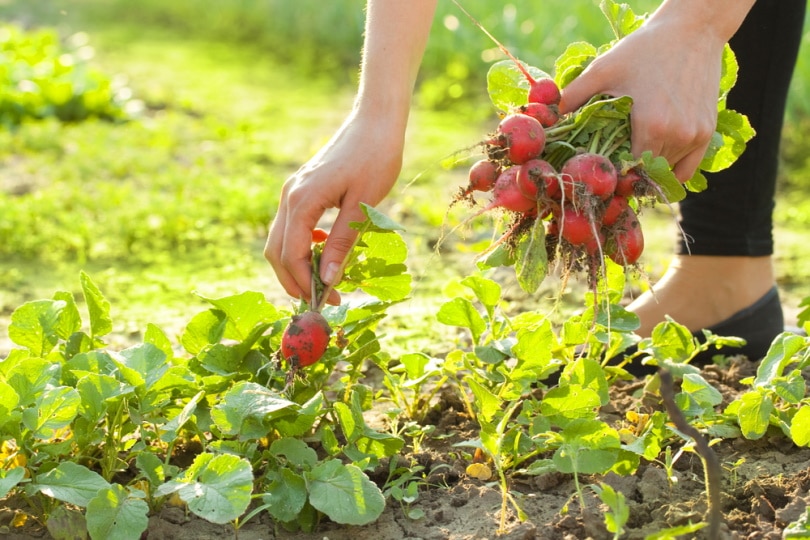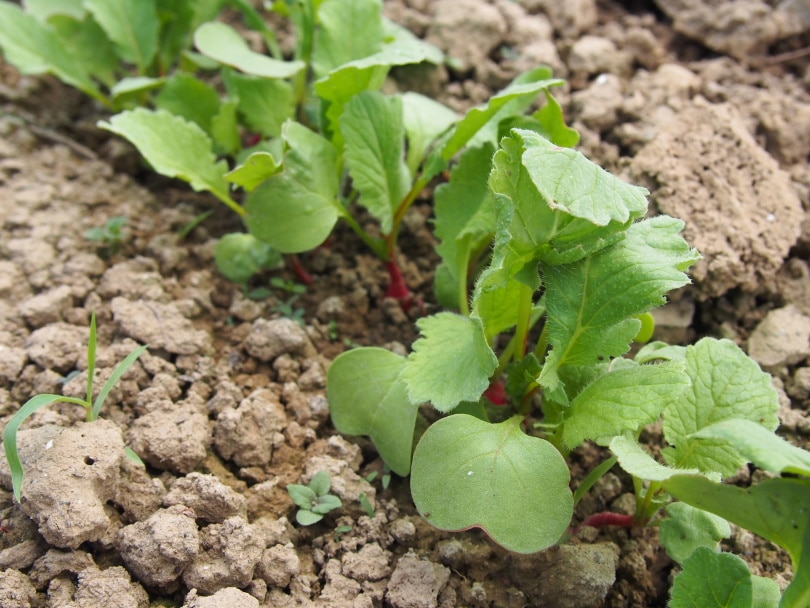How & When to Plant Radishes: Tips, Companions, & FAQ
-
Shea Cummings
- Last updated:

If you are a beginner gardener looking for an easy-to-grow veggie, radishes are worth considering. These root vegetables are hardy and don’t require much care, so they’re a great option to get started with.
The only real weakness that a radish has is that it doesn’t do well in the extreme heat of the summer. So, if you live somewhere that gets sweltering summers, you’ll want to plant your radishes in the spring or fall.
You can harvest a radish around 3 weeks after it’s planted, so even if you plant in the early to mid-fall, you won’t have to worry too much about running into the winter months.
Planting Radishes
Before you plant radishes, there are several things you’ll want to do to ensure the best growing outcomes.
- Remove rocks and clumps of dirt by tilling the garden.
- Ensure that the soil you’re using is not dense and clay-like. You’ll want to mix in a decent amount of compost if it is. This will increase the drainage and loosen the soil for optimal radish growing.
- If you’re planting radishes every year, ensure you only plant them in the same spot once every 3 years. This is known as a 3-year crop rotation.

When to Plant Radishes
As a rule, you’ll want to plant radishes 4–6 weeks before the average final spring frost for early spring planting. And if you’re planting in early fall, you’ll want to sow the seeds 4–6 weeks before the average date of the first fall frost.
The biggest thing to remember is that radishes can’t withstand high summer temperatures. So as long as you can harvest the plant before the heat and before the winter, you’ll be good. Check the seed packet for expected growth times as different varieties grow slightly differently.
Starting Radishes Indoors
It’s not recommended that you start your radishes indoors because when you transplant them, it disturbs their roots, affecting how well they grow. Starting them in the garden is not too big of a deal because of how quickly they grow.
Radish Planting Best Practices
Growing radishes is not complicated. They are a very hardy plant that doesn’t mind the cooler weather. If you follow these best practices, you’ll be enjoying garden-fresh radishes before you know it.
- Sow radish seeds 1 inch apart, approximately 0.5–1 inch deep in the soil.
- Consistent watering is the key to radishes. Unless you’re getting around an inch of rain per week, ensure you’re watering the new plants regularly. Keep them moist, but don’t let the water pool where they are.
- The only fertilizer you need with radishes is when you initially plant them.
- Keep the area around your radishes free of weeds.

How-To Tell When Your Radishes are Ready for Harvesting
The easiest way to tell when to harvest your radishes is to follow the directions on the seed packet. This will provide you with a reasonably accurate timeframe of when to harvest the radish. Another way you can tell is by brushing some soil away from the top of a few of the roots. They’re ready to pull if the root is approximately an inch in diameter.
Companion Planting
You’re likely not going to grow radishes alone in your garden. When it comes to plants, certain ones do better together than others. Here are several plants that grow well with radishes.
- Lettuce
- Celery
- Beets
- Beans
- Cucumber
- Mint
- Parsnip
- Peas
- Spinach
- Squash
- Tomatoes

- Pro tip: Plant several “sacrificial” icicle radishes around their mounds if you’re planting squash or peppers. The radishes will typically draw pests like flea beetles or aphids away from your squash and peppers when the radishes bloom.
Companion Plants to Avoid
Potatoes and Agastache are two plants to avoid putting near radishes. Both will prevent the radish from growing well and, in many cases, will render them unusable.
Storing Your Fresh Radishes
Unless you’re eating them right away, your fresh radishes will grow soft and mushy within a few days. Here are a few things you can do to make them last longer:
- Cold Water: After washing the veggies and cutting off the greens and root tips, place them in a jar of water. Sealed and kept in the fridge, they will last a week or more.
- Frozen: Freezing will preserve most things. However, it does change the flavor and consistency slightly. Blanching them before freezing is recommended.
- Pickling or Dehydration: Both of these methods can preserve the radishes for many months.
- Crisper Drawer: If your fridge has a crisper drawer, wrapping the radishes in a damp paper towel is probably the easiest storage solution. You can expect up to a week or so of freshness.

Conclusion
When done right, you can get a consistent harvest of radishes outside of the middle of summer. These wonderful veggies make a great addition to many dishes or awesome garnishes. By following a few simple best practices and paying attention to the directions on the seed’s packet, you’ll be growing your own radishes in a flash.
Featured Image Credit: originalpunkt, Shutterstock
Contents
